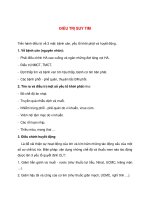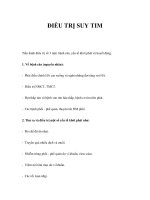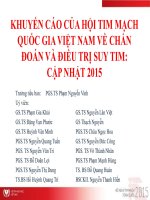DIEU TRI SUY TIM CKD
Bạn đang xem bản rút gọn của tài liệu. Xem và tải ngay bản đầy đủ của tài liệu tại đây (1.21 MB, 23 trang )
Managing
Chronic Heart Failure
Patient
in Chronic Kidney Disease
THS BS TRẦN HỮU HIỀN
1
INTRODUCTION
Epidemiology
Pathophysiology
Management
Modification of risk factors
Diuretic
Angiotensin-converting enzyme inhibitors
Angiotensin II receptor blockers
Beta-blockers
Digoxin
Oxidative stress and
hemodialysis patients
2
3
EPIDEMIOLOGY
4
U.S. Renal Data System. USRDS 2012 Annual Data Report: Atlas of ChronicKidney Disease
and End-Stage Renal Disease in the United States. Bethesda, MD: National Institutes of
Health, National Institute of Diabetes and Digestive and Kidney Diseases; 2012
5
PATHOPHYSIOLOGY
CARDIO-RENAL SYNDROMES (CRS) GENERAL DEFINITION
6
Disorders of the heart and kidneys whereby acute or chronic dysfunction in
one organ may induce acute or chronic dysfunction of the other
ACUTE CARDIO-RENAL SYNDROME (TYPE 1)
Acute worsening of cardiac function leading to renal dysfunction
CHRONIC CARDIO-RENAL SYNDROME (TYPE 2)
Chronic abnormalities in cardiac function leading to renal dysfunction
ACUTE RENO-CARDIAC SYNDROME (TYPE 3)
Acute worsening of renal function causing cardiac dysfunction
CHRONIC RENO-CARDIAC SYNDROME (TYPE 4)
Chronic abnormalities in renal function leading to cardiac disease
SECONDARY CARDIO-RENAL SYNDROMES (TYPE 5)
Systemic conditions causing simultaneous dysfunction of the heart and
kidney
House AA, Anand I, Bellomo R, Cruz D, Bobek I, Anker SD, Acute Dialysis Quality Initiative Consensus Group. Defiition and
classifiation of cardio-renal syndromes: workgroup statements from the 7th ADQI consensus conference. Nephrol Dial
Transplant 2010;25(5):1416–20
7
8
MANEGEMENT
Modification of risk factors*
1. Smoking cessation
2. Exercise
3. Weight reduction to optimal targets
4. Lipid modification recognizing
5. Optimal diabetes control HbA1C <7% (53 mmol/mol)
6. Optimal BP control <130/80 mm Hg
7. Aspirin is indicated for secondary prevention but not primary prevention
8. Correction of anemia to individualized targets
* KDIGO 2012 Clinical Practice Guideline for the Evaluation and Management of Chronic Kidney Disease
9
Diuretics
Major clinical role in reducing fluid
overload in patients with chronic HF and
pulmonary congestion*
Eur Heart J. 2005 Jun;26(11):1115-40. Epub 2005 May 18.
10
Diuretics
First-line loop diuretics GFR ≤30 mL/min per 1.73 m2
The dosage of the loop diuretic should be progressively increased
until the effective dose is reached
Intravenous bolus more effective than oral dose, because
bypassing the gastrointestinal tract overcomes impaired drug
absorption due to gut edema seen in advanced HF
The effective oral or intravenous dose of loop diuretics should be
administered as often as needed to maintain the response
World J Cardiol 2010 May 26; 2(5): 112-117
11
Diuretic Resistance
Sequential blockade of sodium reabsorption in the nephron can
be instituted by administering a distal-acting diuretic, such as
hydrochlorothiazide or metolazone, along with a loop
diuretic in a dose determined according to the patient’s renal
function
Continuous intravenous infusion of diuretics may be more
effective in resistant cases, prevents the post-diuretic salt
retention associated with sequential doses*
J Am Coll Cardiol. 1996 Aug;28(2):376-82.
12
Diuretic Adverse Effects
Decrease in renal function
Hypovolemia
Hypokalemia
Hyponatremia
13
Angiotensin-converting
enzyme inhibitors
Patients with chronic HF, mild-to-moderate renal
insufficiency should not be viewed as a contraindication to ACE
inhibitor therapy, and a mild and nonprogressive worsening of
renal function during initiation of therapy should not be
considered an indication to discontinue treatment, as the drug
may offer the dual benefit of reducing disease progression
in both the heart and the kidney.
Arch Intern Med. 2000 Mar 13;160(5):685-93.
14
Angiotensin-converting
enzyme inhibitors
In patients with moderate or severe renal insufficiency,
therapy with low doses of ACE inhibitors should be initiated and
the dose should be increased gradually with careful monitoring of
renal function and serum electrolytes.
World J Cardiol 2010 May 26; 2(5): 112-117
15
Angiotensin-converting
enzyme inhibitors
When the initiation of ACE inhibitor therapy leads to an increase
in serum creatinine levels >30% above baseline
ACE inhibitors should be discontinued,
The patients should be evaluated for conditions causing renal
hypoperfusion: excessive depletion of circulating volume due to
intensive diuretic treatment, concurrent administration of
vasoconstrictor agents [most commonly, nonsteroid antiinflammatory drugs (NSAIDs)] and severe bilateral renal artery
stenosis. Unless renal vascular disease is present, therapy with an
ACE inhibitor can be reinstituted after correction of the
underlying cause of reduced renal perfusion
World J Cardiol 2010 May 26; 2(5): 112-117
16
Risk of hyperkalemia
associated with ACE
inhibitors*
Discontinuation of drugs known to interfere with renal potassium
excretion (e.g. NSAIDs, including cyclooxygenase-2 inhibitors),
Administration of a low potassium diet
Sodium bicarbonate in patients with metabolic acidosis
A potassium level of >5.5 mEq/L should prompt a reduction in the
ACE inhibitor dose.
*N Engl J Med. 2004 Aug 5;351(6):585-92.
17
Angiotensin II receptor
blockers
Alternative in patients intolerant of ACE inhibitors due to cough,
Combination with ACE inhibitors in patients who remain severely
symptomatic on conventional therapy
Am Heart J. 2007 Jun;153(6):1064-73.
18
Beta-blockers
19
Recommended for all patients with stable mild, moderate or
severe HF who are on standard treatment including diuretics and
ACE inhibitors*
In the SOLVD study, treatment with beta-blockers was associated
with a 30% decrease in the risk of worsening renal
function, both in the ACE inhibitor and the placebo groups (RR
0.70, 95% CI 0.57-0.85)**
*J Am Coll Cardiol. 2004;44:1587-1592
**Am Heart J. 1999 Nov;138(5 Pt 1):849-55.
Digoxin
20
Not affect survival but led to a 28% reduction in HF
hospitalizations.
Used safely in patients with HF and renal insufficiency,
Initiated without a loading dose and maintained at a low dose
(0.125 mg), alternating days
Serum digoxin levels should be monitored to maintain a serum
concentration in the acceptable range of 0.5-1.0 ng/mL
Monitor carefully for symptoms and signs of digoxin toxicity.
N Engl J Med. 1997 Feb 20;336(8):525-33.
Oxidative stress and
hemodialysis patients
Supplementation with 800 IU/day vitamin E reduces
composite cardiovascular disease endpoints and myocardial
infarction*
Treatment with acetylcysteine (600 mg BID)
reduces composite cardiovascular end points**
*Lancet. 2000;356:1213-1218. **Circulation. 2003 Feb 25;107(7):992-5.
21
HOME MESSAGE
Modification of risk factors
ACE inhibitors, ARBs, and β-blockers are the fist-line drugs treat
HF in CKD
Loop diuretics are the first line treat fluid overload
Digoxin use low dose (0.125mg) and close monitoring
Oxidative stress and hemodialysis patients: vitamin E and
acetylcysteine
22
23
THANKS FOR LISTENING









